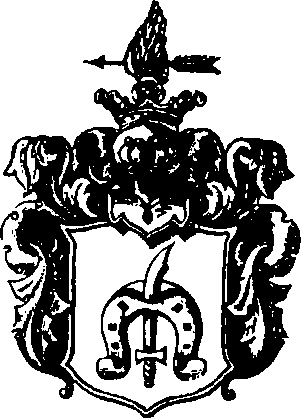Herb Zagloba
Research Heraldry Herb Zagloba
Herbarz Polski translation
Zagloba herb
 For each herb [clan shield, coat of arms] the blazon or verbal description of the arms is first given in authentic heraldic style, followed by a translation from the Polish description by Niesiecki. The right and left sides of a shield are identified from the standpoint of the bearer, i. e., the one holding the shield. His right would be your left and vice versa. The tinctures (colors) in heraldry are as follows: azure = blue, gules = red; sable = black; or = gold, argent = silver; vert = green. In heraldry all charges (pictures) on a shield are assumed to be facing dexter (right side) unless otherwise specified. In Polish heraldry all animals or birds are assumed to be in their natural coloring unless otherwise specified.
For each herb [clan shield, coat of arms] the blazon or verbal description of the arms is first given in authentic heraldic style, followed by a translation from the Polish description by Niesiecki. The right and left sides of a shield are identified from the standpoint of the bearer, i. e., the one holding the shield. His right would be your left and vice versa. The tinctures (colors) in heraldry are as follows: azure = blue, gules = red; sable = black; or = gold, argent = silver; vert = green. In heraldry all charges (pictures) on a shield are assumed to be facing dexter (right side) unless otherwise specified. In Polish heraldry all animals or birds are assumed to be in their natural coloring unless otherwise specified.
Arms: Azure, a horseshoe, Argent heels to base, pierced of a sword in pale point to chief. For a crest, an eagle's wing debruised of an arrow in fess, all proper.
There should be a horseshoe with the tips downward; through its top a saber passes, point upward and hilt downward, facing the right side of the shield, so that the hilt is to be seen in the center of the horseshoe. The helmet with crown has an eagle's wing, through which an arrow passes. Thus it is described in Paprocki's Gniazdo cnoty [Nest of Virtue], p. 96; in O herbach, p. 342; in Okolski, volume 3, p. 328; and in Klejnoty, p. 90. These authors say that these arms come from those of Jastrzebiec, since they are the same colors as Jastrzebiec; but it seems that they originated from Pobóg rather than from Jastrzebiec, as Bielski asserts (p. 283), and for this reason, that they bear a plain horseshoe, not one reversed.
There were two brothers, whether of Jastrzebiec clan or Pobóg, who carried on a long-standing feud between them, and would not let it be settled, neither by the intervention of friends or the persuasion of relatives. It went so far that the younger brother, seeking vengeance for his injury, did not restrain his temper until he was guilty of the blood and death of his older brother. On account of this crime, in eternal memory of his punishment, his descendants' arms were transformed into the shape you see here and called Zagroba or Zagloba, i.e., za glowe [for his head].
The variation in the arms occurred during the reign of Kazimierz the Monk. Abraham Socha, Płock governor, was of these arms, who by his courage won Kujawy for Ziemowit, Duke of Mazovia; however he died, bravely holding his ground, along with so many other Polish lords, in that unfortunate battle between Witold, Prince of Lithuania, and Tamerlane's commander Ediga, in 1399. (Bielski, p. 282. Cromer.) He had numerous progeny, widely scattered, bearing various names from the estates they acquired, but all true Sochas. They are as follows:
Bearers of These Arms
|
Dabrowski |
Krajkowski | Sniegocki |
| Dubina | Kucharski | Sochacki |
| Grabowski | Labunski | Tarchalski |
| Jaroszewski | Mieczkowski | Trzebinski |
| Karwowski | Smarzewski | Trzeszkowski |
| Kleniewski | Smolenski | Zaglobski |
Copyright © 1999 Leonard J. Suligowski. Used by permission. This article originally appeared in Rodziny (August 1999), the journal of the Polish Genealogical Society of America.
;
